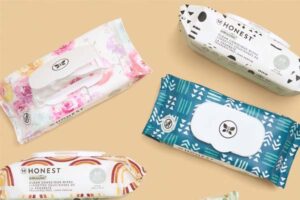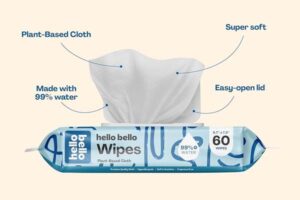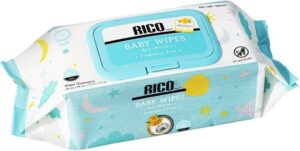
Are you concerned about the environmental impact of disposable baby wipes piling up? You probably feel a bit uneasy tossing them out, knowing they don't just disappear. Let's explore why most common baby wipes stick around for so long.
The main reason most baby wipes aren't biodegradable is because they contain plastic fibers, usually polyester (PET) or polypropylene (PP). These synthetic materials provide strength and softness but don't break down naturally in the environment like plant-based materials do.
These plastic components are popular in wipe manufacturing. They help the wipe hold its shape, absorb liquid effectively, and resist tearing during use. Manufacturers often choose them for cost-effectiveness and performance. However, this durability means they persist long after we've thrown them away. Unlike natural fibers like cotton or wood pulp that microbes can easily consume, these plastics remain largely unchanged in landfills or, worse, if they end up in nature. This causes problems like plastic pollution and contributes significantly to landfill waste. Understanding this helps explain the search for better, more eco-friendly options we see today.
Let's look closer at polyester (PET) and polypropylene (PP). These are strong, cheap plastics. That makes them ideal for single-use products like wipes where performance and cost are key. But their chemical structure is very stable. Bacteria and fungi, nature's recyclers, can't easily break down these man-made polymers. So, when a wipe made with these plastics is discarded, it doesn't rot away. Instead, it might sit in a landfill for hundreds of years. Over time, sunlight and physical stress can cause it to break into smaller pieces, but these are still plastic – we call them microplastics. These tiny bits can contaminate soil and water, posing a risk to ecosystems.
What makes a wipe truly biodegradable?

It's easy to get confused by labels like "natural" or "eco-friendly." So, what does "biodegradable" really mean when we talk about wipes? Let's clarify.
Essentially, a truly biodegradable wipe is made from materials that natural microorganisms (like bacteria and fungi) can digest. They break it down completely into natural elements such as water, carbon dioxide, and organic matter within a reasonable time under specific environmental conditions.
Now let's dive deeper into what makes biodegradation actually work.
Understanding Biodegradability Standards
It's not just about the material; official standards help define what counts as biodegradable or compostable. These ensure claims are reliable.
- ASTM D6400 (USA): This standard is for products designed to be composted in industrial facilities. It sets criteria for disintegration, biodegradation (how much carbon converts to CO2), and eco-toxicity (the compost must be safe for plant growth).
- EN 13432 (Europe): Similar to ASTM D6400, this is the European standard for industrially compostable packaging (often applied to wipes too). It requires specific levels of disintegration, biodegradation, low heavy metals, and no negative effects on the final compost quality.
- Home Compostability Standards (e.g., TÜV AUSTRIA OK compost HOME): These are stricter because home compost piles are cooler and less managed than industrial ones. Products must break down under these less ideal conditions.
Knowing these standards helps you look past vague marketing and find genuinely eco-friendly products.
Key Factors Influencing Breakdown
Several things determine if and how quickly a wipe will biodegrade:
| Factor | Detail | Importance |
|---|---|---|
| Material | Plant-based (cotton, bamboo, wood pulp) vs. Plastic (PET, PP). | Critical |
| Environment | Soil, water, industrial compost, home compost? Temperature, moisture, and oxygen levels matter greatly. | Critical |
| Microbes | The right types and sufficient numbers of bacteria and fungi must be present. | Essential |
| Time | Biodegradation takes time – standards specify how much time is acceptable (e.g., 6 months in compost). | Key Metric |
| Product Size | Thicker or denser materials may take longer to break down than thinner ones. | Factor |
A wipe labeled "biodegradable" might only break down under very specific industrial composting conditions, not necessarily in a landfill or your backyard compost bin.
"Eco-Friendly" vs. Certified Biodegradable
Be cautious with general terms. "Eco-friendly" could mean anything – less water use, recycled packaging, or partially plant-based materials. It doesn't guarantee biodegradability.
- Look for specifics: "100% Plant-Based Fibers," "Made from Viscose/Cotton/Bamboo."
- Check for Certifications: Logos from BPI (Biodegradable Products Institute), TÜV AUSTRIA (OK compost), or FSC (Forest Stewardship Council for wood pulp) provide more assurance.
- Read the Fine Print: Sometimes packaging explains the conditions needed for biodegradation (e.g., "Commercially compostable only").
True biodegradability is about the material, the environment it ends up in, and meeting verified standards.
Are there biodegradable baby wipe options available?
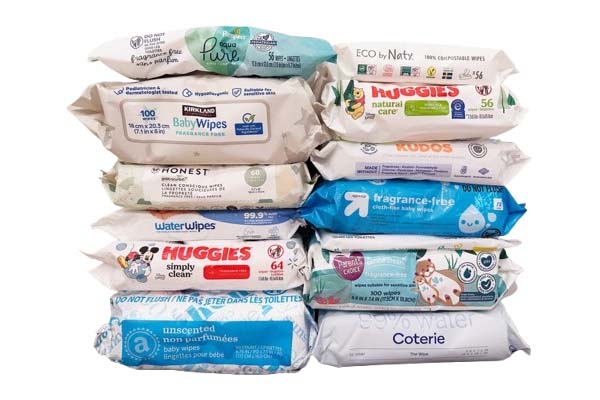
Given the issues with standard wipes, you might be wondering if there are better choices out there. Can you actually find baby wipes that break down?
Yes, absolutely. Biodegradable baby wipes are increasingly available. These wipes are typically made from 100% plant-derived fibers like bamboo, wood pulp (often called viscose or lyocell), organic cotton, or sometimes PLA (derived from corn starch). These materials decompose naturally after disposal.
Let's explore these more sustainable alternatives and what to look for.
Common Plant-Based Materials in Wipes
Manufacturers are using various natural fibers to create biodegradable options:
- Bamboo Viscose: Sourced from fast-growing bamboo grass. It yields a fiber that is soft, strong, and absorbent. Modern processing methods aim to minimize environmental impact.
- Wood Pulp (Viscose, Lyocell, Rayon): Derived from trees, often from sustainably managed forests (look for FSC certification). Lyocell (brand name TENCEL™) is known for using a more eco-friendly, closed-loop solvent process. These fibers are soft and highly absorbent.
- Organic Cotton: A classic natural fiber known for its softness and gentleness. Organic farming avoids synthetic pesticides and fertilizers, although cotton cultivation is water-intensive.
- PLA (Polylactic Acid): A bioplastic usually made from corn starch. It's typically compostable in industrial facilities where high heat helps it break down. Less likely to biodegrade quickly in landfills or home compost.
Each material offers a different combination of performance, sustainability credentials, and cost.
How to Identify Genuinely Biodegradable Wipes
Navigating product labels requires a careful eye. Here’s how to verify claims:
- Check the Material List: Look for explicit mentions like "100% Viscose," "100% Plant-Based Fibers," "Cotton," "Bamboo." Avoid ingredients like "Polyester," "Polypropylene," "PET," "Plastic." If it says "plant-derived," check if it's 100% or just a blend.
- Look for Certifications: Trustworthy logos are your best guide:
- Compostability: BPI Certified Compostable (North America), DIN CERTCO or TÜV AUSTRIA OK compost INDUSTRIAL / HOME (Europe). These verify it meets specific breakdown standards.
- Biobased Content: USDA Certified Biobased Product shows the percentage of new organic carbon (i.e., plant material).
- Forest Management: FSC certification ensures wood pulp comes from responsibly managed forests.
- Read the Disposal Instructions: Some biodegradable wipes are only suitable for industrial composting. The packaging should ideally clarify this. Remember, "biodegradable" doesn't automatically mean "flushable" – never flush wipes!
Performance Comparison: Do They Work as Well?
A key question is whether these eco-options clean effectively. Early biodegradable wipes sometimes lacked the strength or softness of plastic blends. However, technology has advanced significantly.
- Softness & Strength: Modern manufacturing techniques allow plant-based fibers like bamboo viscose and lyocell to be incredibly soft yet durable enough for cleaning messes.
- Absorbency: Natural fibers are often inherently absorbent.
- Formulation: The cleaning solution is just as important. Many biodegradable wipes use gentle, plant-derived ingredients.
At BBWIPES, we focus heavily on ensuring our sustainable options perform excellently. For instance, our AquaRise® technology helps get the most out of the liquid formula using less volume, enhancing efficiency without compromise. We meticulously select materials and design our wipes – whether organic cotton, bamboo, or PLA – to meet high performance standards alongside eco-credentials.
What happens to non-biodegradable wipes after use?
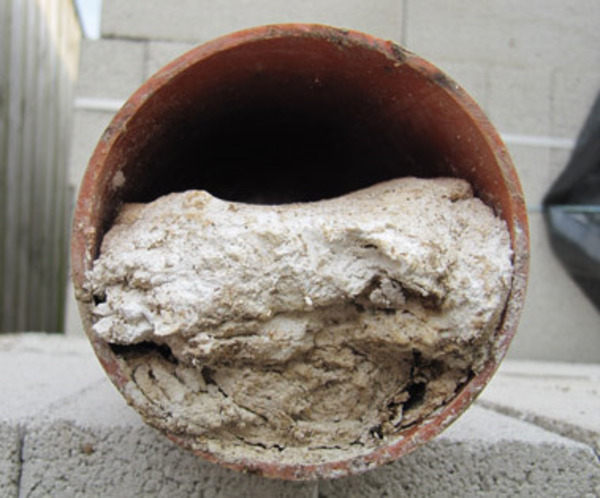
We use them, we toss them, often without a second thought. But where do conventional, plastic-containing wipes go, and what impact do they have?
The vast majority of non-biodegradable wipes end up in landfills. There, they can persist for hundreds of years, slowly breaking down into microplastics. If incorrectly flushed, they cause severe blockages in sewer systems ("fatbergs") and contribute to plastic pollution in rivers and oceans.
Let's trace the journey and consequences of improperly disposed plastic wipes.
The Landfill Legacy
This is the intended destination for wipes thrown in the trash. However, it's far from an ideal solution:
- Space Consumption: The sheer volume of disposable wipes used globally creates enormous amounts of bulky waste, taking up valuable landfill space.
- Longevity: Because they are made of plastic, they don't decompose in the oxygen-poor environment of a landfill. They might remain intact for centuries.
- Microplastic Generation: Over very long periods, physical and chemical processes can cause the plastic fibers to fragment into microplastics. These particles can then potentially leach into the surrounding soil and groundwater (landfill leachate).
Sewer System Chaos: The Fatberg Menace
Flushing wipes is a major problem, regardless of whether the package says "flushable." Most wipes, especially plastic ones, do not break down quickly like toilet paper.
- Pipe Blockages: They easily snag inside pipes and combine with fats, oils, and grease (FOG) poured down drains.
- Fatberg Formation: Over time, these materials accumulate to form huge, solid masses called "fatbergs." These concrete-like lumps block sewer pipes, leading to costly and hazardous overflows.
- Infrastructure Costs: Removing fatbergs is a difficult, expensive, and unpleasant task for municipalities worldwide. The cost is ultimately borne by taxpayers. Cities like London, New York, and Sydney have battled massive fatbergs, highlighting the scale of the issue.
Waterway and Marine Pollution
Wipes that make it through sewers (or enter waterways via storm drains) become a direct source of plastic pollution.
- Visible Litter: They contribute to the unsightly plastic waste found on beaches and in rivers.
- Harm to Wildlife: Marine animals can mistake wipes for food or become entangled in them.
- Microplastic Source: As the wipes slowly break apart in water, they release microplastic fibers, which enter the food chain when ingested by fish and other organisms.
Disposal Reality Check
| Disposal Path | Impact of Plastic Wipes | Recommended Action |
|---|---|---|
| Trash Bin (Landfill) | Adds to landfill volume, persists for centuries, microplastics | Correct (but use biodegradable) |
| Flushing Down Toilet | Causes sewer blockages (fatbergs), pollution, high costs | NEVER DO THIS |
| Composting | Plastic wipes contaminate compost; will not break down | Only if certified compostable |
Proper disposal (in the bin) is essential for all wipes. But choosing biodegradable options significantly reduces the long-term environmental burden.
Finding Sustainable Solutions with BBWIPES
Understanding the problems with traditional wipes naturally leads to seeking better alternatives. That's where we, at BBWIPES, come in. For over 12 years, we've specialized in creating high-quality wet wipe solutions, and sustainability is a core part of our mission.
We know finding reliable, truly biodegradable options can be challenging. We offer:
- Custom Biodegradable Formulations: We work with materials like 100% organic cotton, bamboo viscose, and plant-based PLA non-wovens. We can help you select the right substrate and solution for your needs, whether it's hypoallergenic baby wipes that meet dermatological testing standards or specialized industrial wipes requiring specific certifications.
- Eco-Conscious Innovation: Our AquaRise® technology proves sustainability doesn't mean sacrificing performance. It uses up to 30% less liquid while maintaining 99.9% efficacy, enhancing efficiency without compromise. We also offer advanced options like compostable sachets with a degradation guarantee.
- Regulatory Expertise: Navigating standards like EU Ecolabel, FDA requirements (like 21 CFR or 510(k) clearance), EU Cosmetics Regulation 1223/2009, or compostability certifications can be complex. We have the experience and pre-approved formulations to ensure your product is compliant and market-ready, addressing pain points like Emily's need for validated claims and GHS-compliant SDS, or Luca's need for EU Organic Certification partners.
- Agile Production & Logistics: With 4 automated lines, expandable capacity, and expertise in global shipping (including temperature control and DDP/DAP terms), we ensure reliable supply. Our flexible MOQs (starting from 10,000 units for stock, 50,000 for custom) support brands of all sizes, from startups like Priya's needing novel CBD formulations to large organizations like Henrik's requiring bulk sustainable solutions with waste reduction audits. Our 4-stage quality protocol guarantees consistency.
If you're looking for a manufacturing partner who understands the technical demands and the crucial need for sustainability, we're equipped to help. Let's collaborate to create a wet wipe solution that delights your customers and respects our planet.
Reach out to Timothy Wei, our Global Business Director, at Timothy@bbwipes.com or +86 13750830177 to discuss your project needs or request a complimentary sample kit and brochure.
Conclusion
In short, most baby wipes aren't biodegradable because they contain plastic fibers for strength and cost reasons. However, excellent biodegradable alternatives made from plant fibers now exist. Making informed choices about the wipes we use helps protect our planet from plastic waste.

